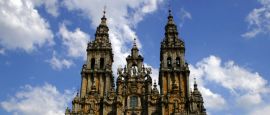A little tourist train goes round the city at a leisurely pace and takes in the main sights. The tour takes about one hour and the train leaves every hour between 1100-1300 and 1600-1900 from Praza do Obradoiro or Avenida Xoán XXIII during the summer season.
Santiago de Compostela tours and excursions
Santiago de Compostela tours
There are several guided tours in English available from Turismo de Santiago's main office at Rúa do Vilar 63. Among the options are a two-hour gastronomy tour, a church tour, a nocturnal tour, an architecture tour and a tour around the Old Quarter. It is also possible to rent an MP3 guide to the city from the tourist office. Walks with local guides are available from the Association of Professional Guides (+34 981 576 698).
Excursions from Santiago de Compostela
The capital of Galicia province, A Coruña is a thriving port and business centre on the north coast of Spain, approximately 60km (37 miles) from Santiago de Compostela. A Coruña has some fine beaches, many striking tourist sights and a bustling and attractive harbour, with a characteristic honeycomb web of white-framed windows on its waterfront. Most notable of these is the Torre de Hércules (Tower of Hercules), an imposing restored Roman lighthouse which still functions. The Old Quarter of the city rivals that of Santiago de Compostela, with monuments such as the beautiful Romanesque church of Santa María do Campo. Trains from Santiago de Compostela to A Coruña run regularly (journey time - 45 minutes). The local tourist information office on the main square provides details of attractions.
The delightful traditional Galician fishing village of Fisterra is just under 50km (31 miles) from Santiago de Compostela. Just a few kilometres short of Cabo Finisterre, it was literally ‘the end of the earth' for medieval pilgrims. It looks straight out over the often-bleak Atlantic and was an ancient holy place for Druids, Romans and Christians. The Costa da Morte (Coast of Death), south of the Cape, is a dramatic landscape of cliffs and sandy beaches. On the south side of the harbour in Fisterra, there are a number of sardiñadas (open-air sardine grills) offering a fine assortment of fresh fish and mariscos (seafood). You can get to Fisterra by bus with Arriva (www.arriva.es). It's a 3km (2 mile) walk to the headland, where, at the cape, a lighthouse perches high above the waves. Beyond the lighthouse and the trinket vendors is the viewpoint, Vista Monte do Facho, which offers spectacular views.
Do you have any Feedback about this page?
© 2025 Columbus Travel Media Ltd. All rights reserved. No part of this site may be reproduced without our written permission, click here for information on Columbus Content Solutions.




 You know where
You know where